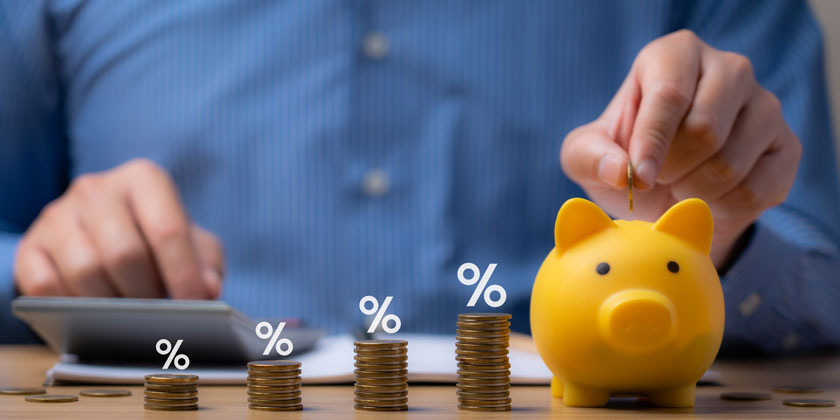Compound growth is one of the most powerful ways to grow money over time. It helps people reach their savings goals without needing constant effort. Many investors see compounding as a key part of building wealth. This is because money grows faster over time, even when you keep putting in the same amount. Let’s break it down in simple terms.
What is Compounding?
Compounding is the process where the earnings from an investment, whether it’s interest, dividends, or capital gains, are reinvested to generate additional earnings. Over time, this leads to exponential growth, as you earn returns not only on your original investment but also on the returns you’ve already accumulated.
Here’s how it works:
- Investing ₹1000 funds would bring you ₹100 interest for the first year of investment.
- The invested ₹1,100 will generate interest on its entire value since you kept it in place rather than cashing out just the ₹1,000 principal amount.
- The pattern of investment and interest accumulation continues without interruption.
That’s compounding!
There are two kinds of interest:
- Simple Interest: You earn interest only on your original money.
- Compound Interest: You earn interest on your original money and the interest it has already earned.
Begin your investing journey today. Your Demat account is the first step.
A Simple Example: Raju vs Ramesh
Let’s say Ram and Shyam both invest ₹1 lakh at 10% interest for 10 years.
- Raju chooses compound interest.
- Ramesh chooses simple interest.
Here’s what happens:
| Person | Types of interest | Final Amount (after 10 years) |
| Raju | Compound | ₹2,59,374 |
| Ramesh | Simple | ₹2,00,000 |
Raju earns ₹59,374 more just because his interest kept growing every year.
Why is Compounding So Powerful?
Compounding works like a snowball, your money grows, then that growth earns more growth. The longer money stays unattended, the faster it grows. Building genuine wealth requires starting early investment alongside maintaining a commitment to invest, which leads to wealth accumulation throughout time.
Let’s look at this:
With an investment of ₹10 lakhs at a 10% interest level, you will acquire ₹16.1 lakhs after five years and ₹25.9 lakhs after ten years, leading to ₹1.74 crores after thirty years.
- In 5 years: ₹16.1 lakhs
- In 10 years: ₹25.9 lakhs
- In 30 years: ₹1.74 crores
Firstly, the money grows steadily, then it accelerates in growth, similar to how a snowball moves quickly down an incline. That’s the magic of compounding.
Recommended Read: How Dividends impact your Stock Returns?
3 Things That Make Compounding Work Best
A full exploitation of compounding effects requires three main elements to become more efficient. Your financial growth in the long term will benefit from maximising your investments when you understand the elements of time, consistent contributions, and a good rate of return.
Interest Rate
Your money will increase speedily as the rate of return rises steadily. A 4% return on a savings account will expand ₹1 lakh to ₹1.48 lakh over ten years. The difference between investing at a 12% equity rate and a 4% savings account becomes apparent because equity grows ₹1 lakh into ₹3.1 lakh, whereas savings grow it only to ₹1.48 lakh in 10 years.
Time
Patience pays off through compounding, as the longer you stay invested, the greater your growth. For example, ₹1 lakh invested for 10 years could grow to ₹2.59 lakhs, but if you leave it invested for 50 years, it could grow to ₹1.17 crores, highlighting the exponential power of compounding over time.
Taxes
If your investment is taxed annually, it can significantly reduce your returns. This is why long-term, tax-efficient options like Equity Linked Savings Scheme (ELSS) mutual funds or Public Provident Fund (PPF) are popular. They help preserve more of your returns over time by minimizing the impact of taxes.
Where Can You See Compounding in Action?
Here’s how different investment options make the most of compounding to grow your wealth:
- Bank Fixed Deposits (FDs): Interest keeps adding up if you don’t withdraw it.
- Mutual Funds (Growth Option): The profits are reinvested, growing your wealth faster.
- Stock Market: Long-term investors see compounding returns through rising stock prices and reinvested dividends.
How to Get the Best Out of Compounding
To truly unlock the power of compounding, keep these three golden rules in mind:
- Start Early: The earlier you begin, the more your money can grow over time, even with small investments.
- Stay Consistent: Invest regularly, no matter how small the amount, and let your wealth accumulate steadily.
- Be Patient: Resist the urge to constantly check or withdraw. Let your investments compound over time for the best results.
Why Don’t More People Use Compounding?
Many people don’t take full advantage of compounding. This is often because they:
- Want quick returns
- Don’t realise how powerful compounding can be
- Keep delaying their investments
But once you get it, you’ll realise how much wealth you could build by simply starting now and staying disciplined.
Conclusion
Compounding quietly works behind the scenes, helping you build wealth over time even while you sleep. The earlier you start and the longer you stay invested, the greater the benefits. So, if you haven’t already, now’s the time to take your first step. Even small investments can lead to big results, as long as you give them time to grow.
Frequently Asked Questions
What is the power of compounding in investment?
In investing, compounding is the process whereby your gains begin to generate their own returns over time. Your wealth increases exponentially when you reinvest your earnings since they create more earnings. Compounding becomes significantly more impactful over extended periods of time.
Does compounding work in FD?
Yes, if you choose the cumulative option, compounding operates in fixed deposits (FDs). In this sense, the interest acquired is reinvested into the deposit, therefore enabling interest on interest. This results in a greater maturity value over time than non-cumulative FDs, in which interest is paid out on regular basis.
Does PPF give compound interest?
Yes, the Public Provident Fund (PPF) offers compound interest. The interest is calculated annually and added to your account, which then becomes part of the principal for the next year. This compounding effect, combined with the long lock-in period of 15 years, makes PPF a powerful tool for long-term, tax-free wealth creation.











